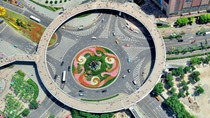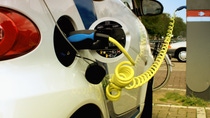Challenges and opportunities for China’s automotive market

China’s automotive industry has been growing rapidly and the country is playing an increasingly important role in the global automotive market. According to the Ministry of Industry and Information Technology (MIIT), China’s countrywide automotive sales have broken through the benchmark of 28 million in 2016, globally ranking first for eight consecutive years.
However, pressing environmental requirements and fierce outside competition are forcing China’s automotive industry to accelerate its innovation and transformation; on the other hand, trends such as consumption upgrades, rise of small towns and the integration of information and communication have complicated demands for automobile consumption.
Facing a rapid change in technology and the growing intricacy of an industrial environment, where will China’s automotive market go? What are the new opportunities?
With the rapid growth of cars in China, vehicle emissions are becoming prominently problematic. China Vehicle Environmental Management Annual Report 2017 showed that the emission from motor vehicles constitutes a major source of air pollution. Therefore, environment protection measures targeting motor vehicles have been taken.
In addition, energy consumption of the traditional automotive industry is relatively high. Xin Guobin, Deputy Minister of Ministry of Industry and Information Technology pointed out that China was lagging behind international standards in terms of passenger vehicle fuel consumption in 2016. China has made a commitment to the world to reach a carbon emission peak in 2030 and increase the proportion of primary energy to 20% (2016: 13.3%). However, based on the current development speed of the auto industry, it is difficult to deliver on this promise.

Energy conservation and emission reduction is the only way for China’s automotive industry to go forward. “According to the green development targets and requirements proposed in the Mid- and Long-term Development Plan for Automotive Industry, the industry will be focusing on light-weighting, fuel consumption reduction and the development of new energy vehicles (NEVs),” said Xu Changming, Deputy Director of State Information Center and Senior Economist.
“Traditional vehicles will still hold an absolute major share in China’s automotive market before 2030,” said Xu, “therefore, low carbonization is the inevitable trend for future vehicles.” In Xu’s view, there are three main ways to meet the stricter limit on fuel consumption: light-weighting, miniaturization and technological upgrade of the traditional engine, all of which need to be supported by advanced materials.
When it comes to new energy technology, the ratio of NEVs is climbing to total sales of new cars. Moreover, the government is actively pushing the development of NEVs with a series of measures. It is clearly stated in the Mid- and Long-term Development Plan for Automotive Industry that by 2020, NEV annual sales will hit 2 million and by 2025 over 20% of car sales will be powered by new energy.
The four main influencing factors for the development of NEVs are: the key technology maturity of battery and whole cars, sale price of a whole car, convenience of charging and the supply chain of NEV production. The introduction of new materials may be the breakthrough in current NEV technology. “Take the fast-growing electric vehicles segment as an example. Battery has been a pivotal difficulty for its production development. With the emergence of ternary cathode materials, the battery can achieve higher energy density than a lithium battery, and in this case, its life span increases. This is a new opportunity created by new materials,” Xu added.
“According to the green development targets and requirements proposed in the Mid- and Long-term Development Plan for Automotive Industry, the industry will be focusing on light-weighting, fuel consumption reduction and the development of new energy vehicles (NEVs).”
Xu Changming, Deputy Director of State Information Center and senior economist
In the consumer market of automobiles, with the development of China’s overall economy and the elevation of Chinese consumers’ purchasing power, an upgrade of consumption is under way.
“Take the luxury vehicle segment for instance. Consumers are changing their definition of ‘luxury’. Nowadays they not only asking for a car with a beautiful appearance, but are paying more attention to the functional performance and fun of driving,” Xu further explained.
Market segmentation and product customization brought by the consumption upgrade set higher standards for the model and interior design, appearance and environmental performance of the materials and coatings, and comfort of drivers and passengers. To meet these needs, an overall increase in research and development is required.
The automotive industry is one of BASF’s key customer industries. In 2016, BASF Group’s total sales reached €57.55 billion, among which automotive driven sales totalled €10 billion – representing approximately 17% of BASF Group’s sales.
“As the biggest supplier of chemical materials for the global automotive industry, BASF supports China’s auto industry to transform and upgrade with advanced materials,” said Dr. Zheng Daqing, Senior Vice President, Business & Market Development Greater China, BASF, “and we tackle challenges and seize opportunities together with the OEMs, auto parts suppliers and all partners along the automotive industry chain.”
“As the biggest supplier of chemical materials for the global automotive industry, BASF supports China’s auto industry to transform and upgrade with advanced materials, tackles challenges and seizes opportunities together with the OEMs, auto parts suppliers and all partners along the automotive industry chain.”
Dr. Zheng Daqing, Senior Vice President, Business & Market Development Greater China, BASF

The mounting pressure of environmental protection in China has triggered a series of policies affecting the automotive industry. BASF strives to promote sustainable transportation with customers through multiple innovative solutions along the entire value chain of the automotive industry.

To reduce the impact to environment, BASF offers customers a series of innovative and effective solutions, including catalyst and coating solutions that help reduce emissions and energy consumption, interior and cabin air purification solutions that help reduce VOC (volatile organic compounds), automotive fluid management solutions that help increase power efficiency and fuel economy, among others.
Light-weighting is another important technical field for energy saving and emission reduction. BASF also provides diversified lightweight solutions, including composite materials, polyurethane systems, metal injection molding solutions, among others. These solutions help reduce weight as well as improve the strength and elasticity of structures and parts, realizing more unique designs.
BASF is also actively planning in the field of NEV. “Foreseeing China’s promising future with NEVs, BASF moved its global headquarters for the business unit of battery material to Shanghai in 2015,” Zheng points out. “In the field of the cathode materials of batteries, BASF products cover from LFP (lithium iron phosphate) materials, which is a major component in the market, ternary cathode materials including NCM (nickel cobalt manganese) to quite mature NCA (nickel cobalt aluminum) materials. To meet market demand, BASF will continue to invest in the R&D of innovative battery material and set to solving the cost and sustainability problems of cathode active materials as a core task.”
Light-weighting is also significant for increasing NEV’s overall performance. BASF is also developing new applications especially for NEVs. With its excellent resistance to high temperatures, Ultramid® polyamide engineering plastic is used in the connectors and wire harnesses in the electric car charging system. It can not only withstand the stresses of delivering high levels of electricity but also resist weathering conditions outdoors. Ultramid has been applied to electric cars of major Chinese OEMs. It is also used for e-motor mounts.

As consumers’ demands become more sophisticated, creativity emerges as the key for automakers to make a difference in the competition in the marketplace.
Personalized design has become a decisive factor. As an innovative solution for car design, BASF’s transfer coating technology valure® can be applied to the surface of leather and many substrates (both natural and synthetic based) for auto interiors. It uses a laser engraved mold which can replicate natural surfaces, technical structures and complex designs and creates a soft touch. Integrating its broad portfolio of colorants and effect pigments, the newly established “Colors & Effects” brand further strengthens BASF’s expertise in the color design for automotive coating, in addition to other industries. It offers both car makers and car buyers a diverse selection.

Local OEMs are booming with their in-depth understanding of local consumers. “We now see that the demand from local OEMs for high quality and innovative materials is growing fast,” said Zheng. “And we collaborate with China’s major local OEMs to boost local innovation with the support of our global and local R&D networks.”
Currently, BASF has established a rewarding partnership with China’s main local auto companies like SAIC and Great Wall, providing innovative solutions for their needs.

To better serve its local customers, BASF has been strengthening its local R&D capacity. In June 2017, BASF announced its investment to build its first regional Automotive Application Center in Asia Pacific based at the BASF Innovation Campus Asia Pacific (Shanghai). The automotive business and R&D teams based at the same location will work closely with the BASF Global R&D center, developing solutions for automotive companies and component suppliers.
“Supported by strong local production and innovation capacity, BASF and its local partners, customers and suppliers will have more opportunities,” Zheng concluded.


